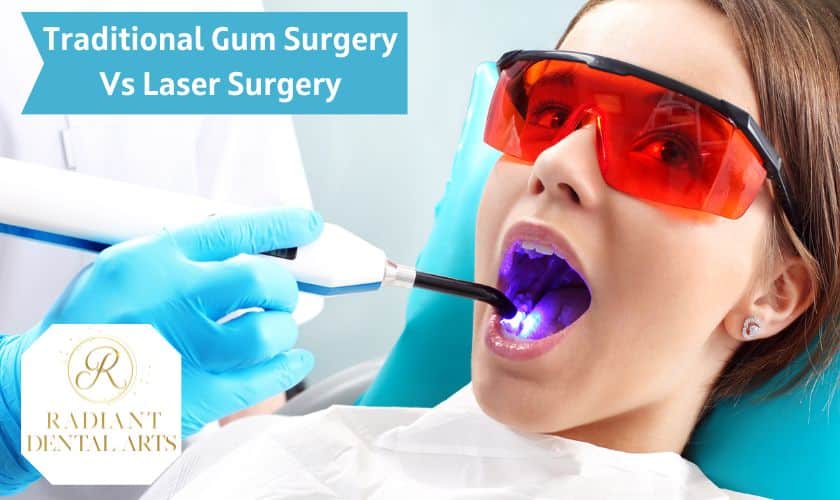Did you know that one out of every two people in the United States over 30 has periodontal disease? Gum disease is an inflammatory condition that lasts for a long time and can affect the gum tissue and the bone under the gums that hold the teeth in place.People must decide whether to have a laser or traditional surgery when they have periodontal disease. Before you get into either of these options, you need to know the main differences between them, even though they are both good choices.
Always remember that healthy teeth and gums are essential for a great smile. In addition to these benefits, it will make you look younger, give you an air of sophistication, and make you feel more comfortable in social situations. So, it would help if you treat it right away before it’s too late.
Traditional Vs Laser Methods Of Treatment
1. Scalpel
The dentist uses a scalpel to cut away unhealthy gum tissue and remove microorganisms during traditional gum surgery. This will make it possible to get to the roots of the teeth, which is needed for a thorough cleaning and shaping of the bone.
Afterward, sutures will be used to put the gums back where they should be. Patients have to take medicine to make them sleepy, which makes flap surgery more painful.
On the other hand, the LANAP procedure used to treat gum disease is only slightly invasive. Since the laser is a non-invasive method, there is no need for a scalpel, gums cutting, or stitches. It is perfect for people with gum disease who want to take care of it with as little pain as possible.
2. Bone Grafting
When the gums pull away from the roots of the teeth, grafting may be needed to reconnect them. Loss of healthy tissue can also mess up the way the teeth look and make them more sensitive.
On the other hand, laser technology is used to remove diseased tissue and harmful germs from gum pockets while keeping the health of gum tissue.
When the dentist cleans the pocket, they will use a laser to press the gum tissue against the root’s surface. In the last step, the tissue is held together with a fibrin clot. This will make it less likely that sensitivity, bleeding, and infections will happen in the future.
3. The Making of a New Bone
Several studies and research projects have shown that the laser-assisted new attachment treatment may help gum tissue reattach to the roots of teeth. It encourages your body to make new bones around your existing teeth. On the other hand, this doesn’t happen when a surgeon uses a scalpel.
4. Recuperation Period
In the past, gum surgery was done by putting a lot of packing material and sutures between the gums. When patients first wake up, they often need to be given a prescription for pain medicine to help them feel better.
The laser surgery, on the other hand, takes about two hours. A local anesthetic will only numb the body parts that will be worked on. Also, the patients can expect to return to normal a day after the procedure. Because of this, patients can return to their normal lives immediately.
5. Fear
In severe cases of periodontitis, the patient’s gum tissue may need to be surgically removed so that the dentist can get to the periodontal pocket. On average, the gumline shrinks between 10 and 15 millimeters. The patient is likely to feel anxious throughout the whole process.
Laser gum surgery, on the other hand, makes going to a periodontist to treat gum disease less scary and less likely to cause worry. This is because the gum line isn’t pulling away from the teeth.
What Are The Benefits Of Laser Gum Surgery?
Laser gum surgery is a great alternative to the more common method of using a scalpel to cut into the gums. Some of the reasons why are listed below:
The Benefits
- The FDA has approved an alternative to gum surgery.
- Safe for everyone
- There’s no reason to put anything in.
- To treat gum disease, you only need to go to the dentist once.
- There is little chance of pain, worry, or infection.
- A reduction in bleeding, swelling, and tooth sensitivity
- Faster time to get better.
- No compromise to smile
Do you have pain when you chew, or are your gums pulling away from your teeth? If you said “yes,” you will likely have gum disease. It doesn’t sound, and sometimes there are no signs until the end of the process. So, the best way to ensure your teeth are safe is to get gum surgery as soon as possible.
It can be fixed with either laser surgery or surgery with a knife. In both cases, patients need to do what their dentists tell them to do to reduce the risk of problems after the surgery. Look around your neighborhood for a dentist known for being knowledgeable and good at treating gums. They will be able to help you choose the one that fits your needs the best.Visit our dental office to know more about Traditional and Laser Gum Surgery.

